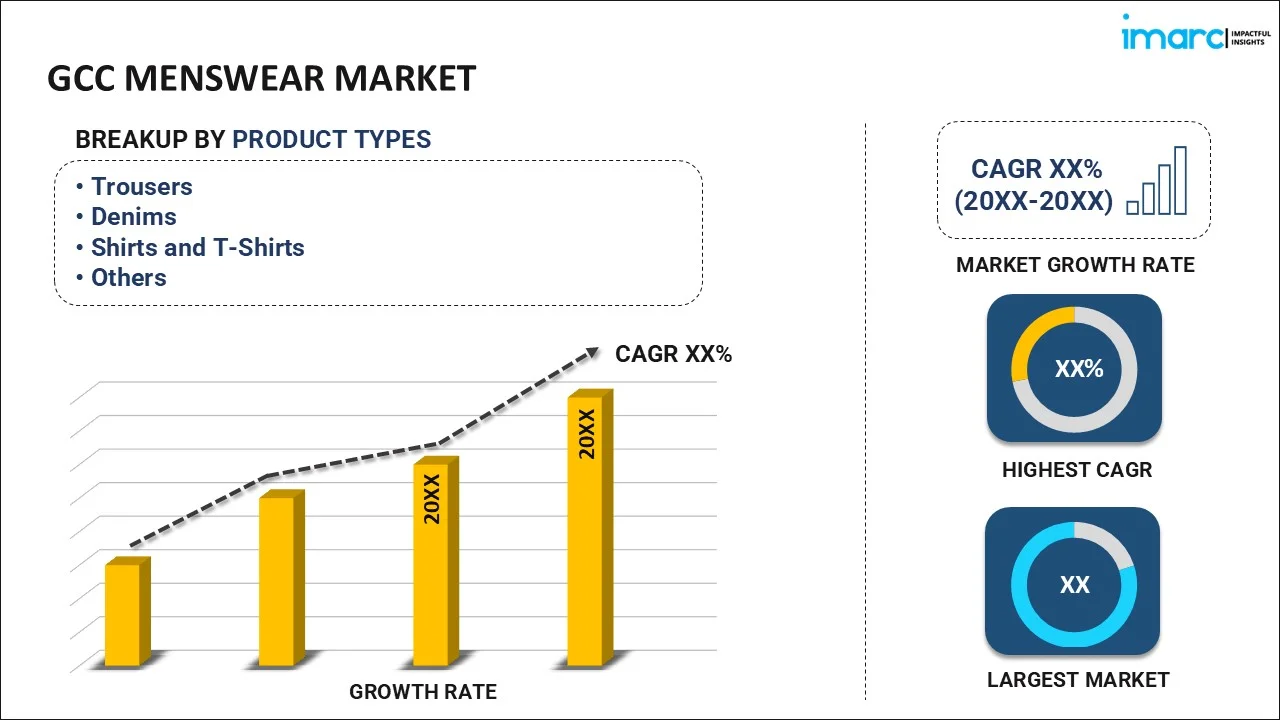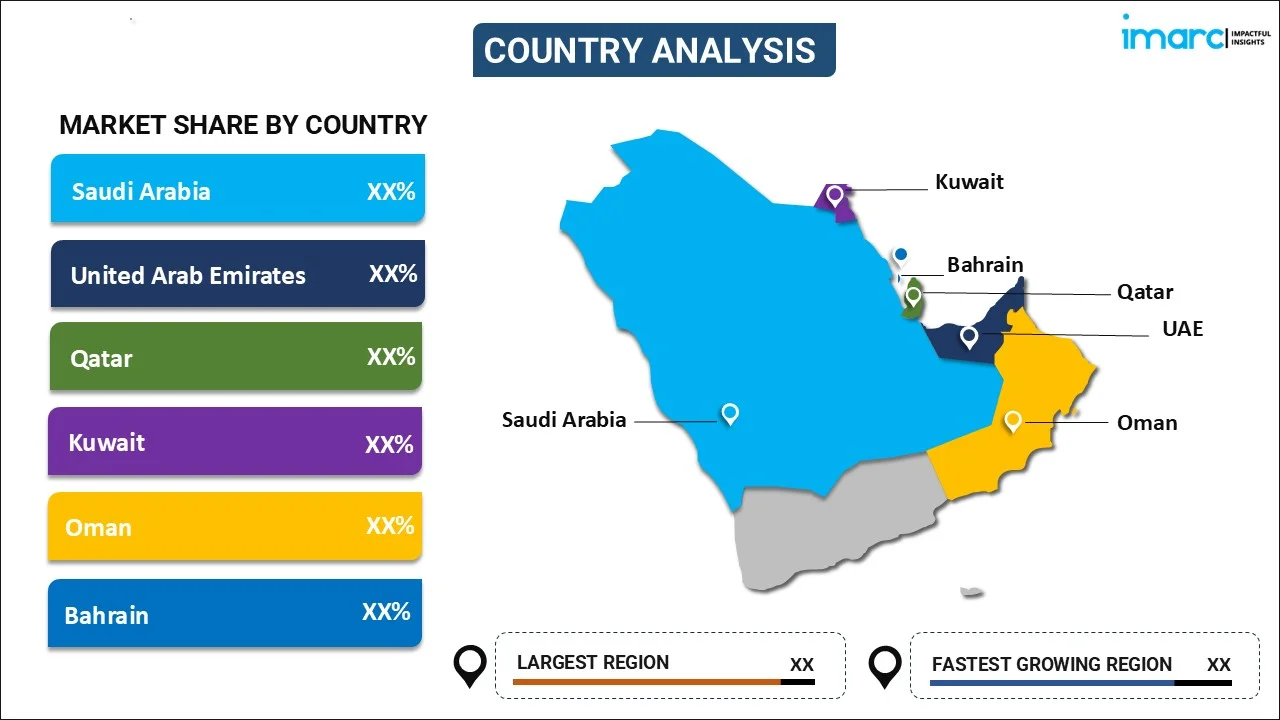IMARC made the whole process easy. Everyone I spoke with via email was polite, easy to deal with, kept their promises regarding delivery timelines and were solutions focused. From my first contact, I was grateful for the professionalism shown by the whole IMARC team. I recommend IMARC to all that need timely, affordable information and advice. My experience with IMARC was excellent and I can not fault it.
Read More
GCC Menswear Market Report by Product Type (Trousers, Denims, Shirts and T-Shirts, Ethnic Wear, and Others), Season (Summer Wear, Winter Wear, All-Season Wear), Distribution Channel (Supermarkets and Hypermarkets, Exclusive Stores, Multi-Brand Retail Outlets, Online Stores, and Others), and Country 2024-2032
Market Overview:
The GCC menswear market size reached US$ 12.1 Billion in 2023. Looking forward, IMARC Group expects the market to reach US$ 17.0 Billion by 2032, exhibiting a growth rate (CAGR) of 3.9% during 2024-2032. The escalating demand for trendy and stylish clothing, the increasing popularity of social media and celebrity endorsements, and the rising awareness regarding sustainable and trendy fashion choices represent some of the key factors driving the market.
|
Report Attribute
|
Key Statistics
|
|---|---|
|
Base Year
|
2023
|
|
Forecast Years
|
2024-2032
|
|
Historical Years
|
2018-2023
|
|
Market Size in 2023
|
US$ 12.1 Billion |
|
Market Forecast in 2032
|
US$ 17.0 Billion |
| Market Growth Rate 2024-2032 | 3.9% |
Menswear refers to clothing and fashion items specifically designed and customized for men. It encompasses several garments and accessories that cater to the diverse style preferences and needs of the male population, from formal attire to casual wear, menswear is evolving over the years, reflecting changes in cultural, social, and fashion trends. It serves functional purposes such as protection and comfort, and now as a means of self-expression and status, leading to the emergence of more elaborate and sophisticated garments, particularly among the upper classes. Modern menswear is influenced by global fashion trends, cultural heritage, climate, and individual tastes. Some common items in menswear wardrobes include customized suits, dress shirts, trousers, jeans, t-shirts, polo shirts, jackets, coats, and various types of footwear such as dress shoes, sneakers, and boots. Contemporary menswear designers and brands continually push boundaries, blending traditional elements with innovative techniques and materials, catering to formal events, business settings, casual outings, sports activities, and everything in between. Nowadays, menswear is witnessing significant changes in silhouette, color palettes, and fabrics, reflecting the dynamic nature of fashion, while classic and timeless pieces persist, modern menswear encourages experimentation and self-expression, empowering men to embrace their individuality through clothing choices across the gulf cooperation council (GCC) region.
GCC Menswear Market Trends:
The market is primarily driven by the escalating demand for trendy and stylish clothing options. Additionally, rapid urbanization, rising disposable income, a growing population of young, fashion-conscious men, the influence of fashion, and the rise of social media are shaping the preferences of men, leading to an increased focus on personal style and grooming, influencing the market growth. Also, menswear retailers and brands are adapting their offerings to cater to this by introducing contemporary designs and innovative collections that resonate with the youthful consumer base, thus augmenting the market growth. Moreover, significant expansion in the e-commerce sector provides consumers greater convenience and accessibility to numerous products representing another major growth-inducing factor. Along with this, online shopping platforms and mobile applications are instrumental in connecting menswear retailers with their target audience, offering a seamless shopping experience, thus propelling market growth. Also, brands are capitalizing on this digital shift by optimizing their online presence, enhancing user interfaces, and using social media for targeted marketing campaigns, thus providing a positive thrust to market growth. Furthermore, environmentally conscious consumers are seeking sustainable and eco-friendly menswear options, brands that prioritize ethical sourcing, utilize eco-friendly materials, and adopt responsible manufacturing processes are gaining popularity among consumers who value sustainability and environmental preservation, thus creating a positive market outlook.
GCC Menswear Market Segmentation:
IMARC Group provides an analysis of the key trends in each segment of the GCC menswear market report, along with forecasts at the regional and country levels for 2024-2032. Our report has categorized the market based on product type, season, and distribution channel.
Product Type Insights:

- Trousers
- Denims
- Shirts and T-Shirts
- Ethnic Wear
- Others
The report has provided a detailed breakup and analysis of the market based on the product type. This includes trousers, denims, shirts and t-shirts, ethnic wear, and others.
Season Insights:
- Summer Wear
- Winter Wear
- All-Season Wear
A detailed breakup and analysis of the market based on the season has also been provided in the report. This includes summer wear, winter wear, and all-season wear.
Distribution Channel Insights:
- Supermarkets and Hypermarkets
- Exclusive Stores
- Multi-Brand Retail Outlets
- Online Stores
- Other
A detailed breakup and analysis of the market based on the distribution channel has also been provided in the report. This includes supermarkets and hypermarkets, exclusive stores, multi-brand retail outlets, online stores, and others.
Country Insights:

- Saudi Arabia
- UAE
- Qatar
- Bahrain
- Kuwait
- Oman
The report has also provided a comprehensive analysis of all the major regional markets, which include Saudi Arabia, the UAE, Qatar, Bahrain, Kuwait, Oman.
Competitive Landscape:
The report has also provided a comprehensive analysis of the competitive landscape in the market. Competitive analysis such as market structure, key player positioning, top winning strategies, competitive dashboard, and company evaluation quadrant has been covered in the report. Also, detailed profiles of all major companies have been provided.
GCC Menswear Market Report Coverage:
| Report Features | Details |
|---|---|
| Base Year of the Analysis | 2023 |
| Historical Period | 2018-2023 |
| Forecast Period | 2024-2032 |
| Units | US$ Billion |
| Scope of the Report | Exploration of Historical and Forecast Trends, Industry Catalysts and Challenges, Segment-Wise Historical and Predictive Market Assessment:
|
| Product Types Covered | Trousers, Denims, Shirts and T-Shirts, Ethnic Wear, Others |
| Seasons Covered | Summer Wear, Winter Wear, All-Season Wear |
| Distribution Channels Covered | Supermarkets and Hypermarkets, Exclusive Stores, Multi-Brand Retail Outlets, Online Stores, Others |
| Countries Covered | Saudi Arabia, UAE, Qatar, Bahrain, Kuwait, Oman |
| Customization Scope | 10% Free Customization |
| Report Price and Purchase Option | Single User License: US$ 3699 Five User License: US$ 4699 Corporate License: US$ 5699 |
| Post-Sale Analyst Support | 10-12 Weeks |
| Delivery Format | PDF and Excel through Email (We can also provide the editable version of the report in PPT/Word format on special request) |
Key Questions Answered in This Report:
- How has the GCC menswear market performed so far and how will it perform in the coming years?
- What has been the impact of COVID-19 on the GCC menswear market?
- What is the breakup of the GCC menswear market on the basis of product type?
- What is the breakup of the GCC menswear market on the basis of season?
- What is the breakup of the GCC menswear market on the basis of distribution channel?
- What are the various stages in the value chain of the GCC menswear market?
- What are the key driving factors and challenges in the GCC menswear market?
- What is the structure of the GCC menswear market and who are the key players?
- What is the degree of competition in the GCC menswear market?
Key Benefits for Stakeholders:
- IMARC’s report offers a comprehensive quantitative analysis of various market segments, historical and current market trends, market forecasts, and dynamics of the GCC menswear market from 2018-2032.
- The research study provides the latest information on the market drivers, challenges, and opportunities in the GCC menswear market.
- Porter's five forces analysis assist stakeholders in assessing the impact of new entrants, competitive rivalry, supplier power, buyer power, and the threat of substitution. It helps stakeholders to analyze the level of competition within the GCC menswear industry and its attractiveness.
- Competitive landscape allows stakeholders to understand their competitive environment and provides an insight into the current positions of key players in the market.
Need more help?
- Speak to our experienced analysts for insights on the current market scenarios.
- Include additional segments and countries to customize the report as per your requirement.
- Gain an unparalleled competitive advantage in your domain by understanding how to utilize the report and positively impacting your operations and revenue.
- For further assistance, please connect with our analysts.

Purchase Options
Benefits of Customization
Personalize this research
Triangulate with your data
Get data as per your format and definition
Gain a deeper dive into a specific application, geography, customer, or competitor
Any level of personalization
Get in Touch With Us
UNITED STATES
Phone: +1-631-791-1145
INDIA
Phone: +91-120-433-0800
UNITED KINGDOM
Phone: +44-753-714-6104
Email: sales@imarcgroup.com
 Inquire Before Buying
Inquire Before Buying Speak to an Analyst
Speak to an Analyst  Request Brochure
Request Brochure  Request Customization
Request Customization



.webp)




.webp)












